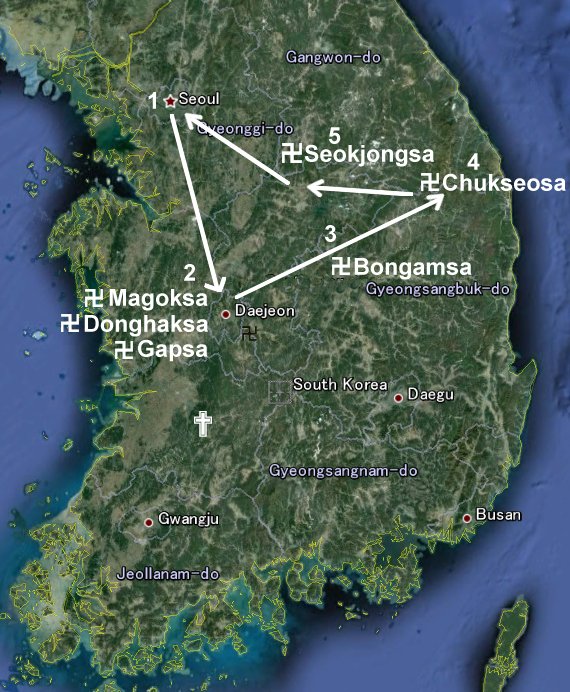|
KOREAN KANHWA SŎN BUDDHISM -- SPECIAL REPORT
|
|

Top Menu
Introduction
|

Architecture
 25 Photos 25 Photos
|

Creatures
42 Photos
|

Deities
59 Photos
|

Doors
13 Photos
|

Paintings
64 Photos
|

People
32 Photos
|

Votive Icons
21 Photos
|
|
Also See

|
Korean Influence on Early Japanese Buddhism. Not a systematic study, but rather a "sketch" of the key contributions
of Korean monks, artisans, and specialists to early Japanese Buddhist doctrine, art, and architecture. 30 Photos.
|
|
ARCHITECTURE AND LANDSCAPE IN KOREA. Many of Korea's temples were destroyed over the centuries by fire, natural disaster, and invading Japanese troops. The temples we visited are all important to Korean Seon (Sŏn) practice. Most were rebuild in the late 19th century or later. The temples, palaces, and residences we visited include: Gyeongbokgung Palace (Seoul) Bukchon Village (Seoul), Magoksa Temple, Donghaksa Temple, Gapsa Temple, Bongsama Temple, Chukseosa Temple, Seokjongsa Temple, and others (see map below).
|
|
|
|
|
|
|
|
|
|
|
|
|
PHOTO CREDITS. All photos by Mark Schumacher (unless stated otherwise). Taken during a conference, meditation retreat, and tour related to Kanhwa Sŏn 看話禪 and Hwadu 話頭 meditative techniques (the Korean counterpart of Zen Kōan meditation). The event took place in Korea between June 23 and July 3, 2012. It was organized by the Center for the Study of the Chogye Order (Chonghak Yŏn'guwŏn) at Dongguk University. Participants included advanced graduate students, professors, and independent scholars in Korean Religions and Buddhist Studies. The retreat was held at Magoksa Temple, a few hours south of Seoul. If you would like to submit your own photo(s) for inclusion here (with credits to you), please contact me. If you have a Facebook account, you can also post your photos at the Korea Kanhwa Sŏn Facebook Group Page.
|
|
Temple's We Visited and Online Temple Resources
|
- Magoksa Temple (K = 마곡사, C = 麻谷寺)
Magoksa Temple Homepage || Temple Review at KoreaTemple.net
Magoksa, located in Gongju, South Korea, is the head temple of the Jogye Order of Korean Buddhism. It is here that our group held its meditation retreat between June 23 and July 1.
- Donghaksa Temple (K = 동학사, C = 東鶴寺)
Temple review by KoreaTemple.net. || Temple review by Buddhist-tourism.com
Largest center of study for female monks in Korea, Donghaksa specializes in Buddhist studies and is part of the Jogye order.
- Gapsa Temple (K = 갑사)
Gapsa Homepage || Temple review by Koreatemple.net
- Bongamsa Temple. 鳳巖寺. One of the Nine Mountain Schools (禪門九山) of Seon practice in Korea. Here we heard a Dharma talk from Master Jeokmyeong . This temple, says Visitkorea.or.kr, is "open to the public only one day per year. Visit on any day other than Buddha's Birthday and you will be turned away at the gate. A major Korean center for the practice of Seon (better known in the West by its Japanese name of Zen). Bongamsa is one of Korea's oldest centers of Seon meditation. This Seon tradition continues to this day. In 1982, the temple and the surrounding mountain and forests were closed off to the outside world to produce a better meditation environment. Not surprisingly, there's a good deal of competition between monks to enter the monastery, where monks, from the abbot on down, meditate for at least eight hours a day." <end quote>
- Chukseosa Temple 鷲棲寺. Here we heard a Dharma talk from Master Muyeo 無如.
Temple review by Bonghaw.go.kr || Temple review at KBS.co.kr || About temple's Yakushi statue.
- Seokjongsa Temple. Here we heard a Dharma talk from Master Hyeguk.
See details at Chungbuk Nadri.net.
- Other Temple Resources

Location of temples we visited in South Korea
|
|
Nine Mountain Schools of Seon (Sŏn) Practice in Korea 禪門九山
|
|
Nine Mountain Schools 禪門九山 (C = Chánmén Jiǔshān, K = Seonmun Gusan 선문구산, J = Zenmon Kyūsan). An appellation for the early schools of Korean Seon (Sŏn) practice. Each school was connected with one of nine mountain monasteries. The nine are listed below.
- Gaji-san school (迦智山), established at Borimsa (寶林寺) under the influence of Doui (道義; d. 825) and his grand-student Chejing (體澄; 804–890). Doui studied in China under Zhizang (智藏; 735–814) and Baizhang (百丈; 749–814).
- Seongju san (聖住山) school, established by Muyeom (無染; 800–888) who received his inga 印可 from Magu Baoche (麻谷寶徹; b. 720?).
- Silsang san (實相山) school, founded by Hongcheok (洪陟; fl. 830), who also studied under Zhizang.
- Huiyang san (曦陽山) school, founded by Beomnang and Jiseon Doheon (智詵道憲; 824–882), who was taught by a Korean teacher of the Mazu transmission.
- Bongnim san (鳳林山) school, established by Wongam Hyeon'uk (圓鑑玄昱; 787–869) and his student Simhui (審希, fl. 9c). Hyeon'uk was a student of Zhangjing Huaihui (章敬懷暉; 748–835).
- Dongni san (桐裡山) school, established by Hyecheol (慧徹; 785–861) who was a student of Jizang.
- Sagul san (闍崛山) school, established by Beom'il (梵日; 810–889), who studied in China with Yanguan Qian (鹽官齊安; 750?-842) and Yueshan Weiyan (樂山惟嚴).
- Saja san (獅子山) school, established by Doyun (道允; 797–868), who studied under Nanjuan puyuan (南泉普願; 748–835).
- Sumi-san school (須彌山) founded by Ieom (利嚴; 869–936), which had developed from the Caotong (曹洞) lineage. The term Gusan in Korea also becomes a general rubric for 'all the Seon schools,' holding such connotations down to the present.
Source: Digital Dictionary of Buddhism (sign in with user name = guest)
The DDB includes much more information about the nine. A visit is highly recommended.
|
|